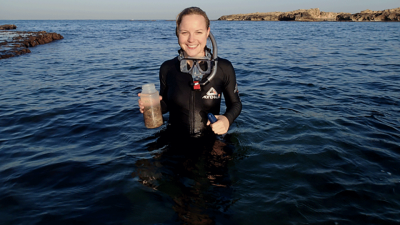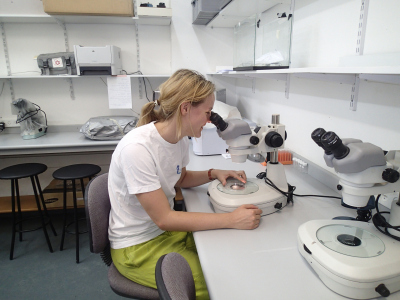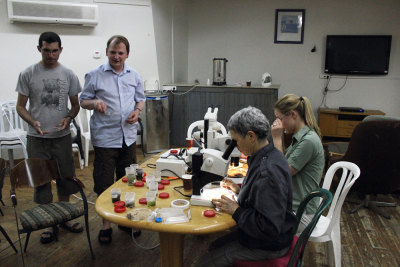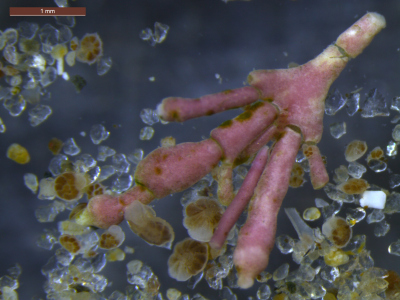Page path:
- Home
- Discover
- Media Releases
- Media Releases 2015
- A Grand Voyage for Tiny Organisms
A Grand Voyage for Tiny Organisms
The foraminifera Pararotalia is a very unimpressive animal at first glance. It is unicellular and very small. Despite this, foraminifera play an important role in the stabilization of ecosystems in the coastal zone. The calcite shells of dead animals form the foundation for many reef ecosystems and have a fundamental importance as so called-ecosystem engineers. Foraminiferal specialists such as Dr. Christiane Schmidt can identify foraminifera by the shape of their calcite shells. Together with her future MARUM colleagues the geo-ecologist, who will return to Bremen after completing a short-term fellowship in Japan, collected samples of living foraminifera at the Nachscholim National Park, south of Haifa, from the spring of 2012 to autumn 2013. One object of their search was the newly described Foraminifera Pararotalia, which was first discovered in 1994 in the eastern Mediterranean and has multiplied explosively there since then.
“To date there is no evidence of the occurrence of this species in the Red Sea,” says Dr. Schmidt. MARUM researcher Dr. Raphael Morard, who conducted the molecular identification on this species adds: “With these methods we can show that Pararotalia is indeed an invasive species that originates from the Indian Ocean and the Pacific.”
The success of the genus Pararotalia in the Mediterranean can be attributed to its ecology. This foraminifer lives in symbiosis with tiny microalgae. This symbiosis provides two advantages: foremost, the algae provide food for the Pararotalia through photosynthesis, and this also promotes the growth of the calcite shell of its host.
“Basically it is the temperature regime in the eastern Mediterranean that dictates whether species such as Pararotalia can survive or not,” Dr. Schmidt says. “We have cultured this species in the laboratory and shown that its thermal optimum is around 28°C, but below 20°C and above 35°C it has extreme difficulty surviving.
Next, the team developed a computer model to determine which regions in the eastern Mediterranean are especially well suited for Pararotalia. The model takes into account all occurrence records of this species published to date and, based on the light regime and sea-water turbidity in these locations, both important factors for the survival of the species, models where it is likely to occur now and in the future. The model gives clear results: the coastal ecosystems of Israel and Lebanon are currently the best-suited habitats for this species, but the species currently also lives in Syria and southeastern Turkey.
The model also suggests that in the future Pararotalia will likely expand to areas in the Mediterranean that are still too cold for its survival today. Increasing sea-water temperatures will lead to migration of the species into the western Mediterranean. Co-author Dr. Anna Weinmann, researcher at the University of Bonn says: “Our model clearly shows that by 2100 Pararotalia will likely be found in the Aegean, the Ionic Sea, in Greece, and in Libya due to transport by the prevailing currents.”
Publication:
Christiane Schmidt, Raphael Morard, Ahuva Almogi-Labin, Anna E. Weinmann, Danna Titelboim, Sigal Abramovich, Michal Kucera
Recent Invasion of the Symbiont-Bearing Foraminifera Pararotalia into the Eastern Mediterranean Facilitated by the Ongoing Warming Trend
In: PLOS ONE online, 13th August 2015
More information / interview requests / photos:
Jana Stone
MARUM Science Communication
Phone ++49 - 421 - 218-65541
E-mail: [Bitte aktivieren Sie Javascript]
“To date there is no evidence of the occurrence of this species in the Red Sea,” says Dr. Schmidt. MARUM researcher Dr. Raphael Morard, who conducted the molecular identification on this species adds: “With these methods we can show that Pararotalia is indeed an invasive species that originates from the Indian Ocean and the Pacific.”
The success of the genus Pararotalia in the Mediterranean can be attributed to its ecology. This foraminifer lives in symbiosis with tiny microalgae. This symbiosis provides two advantages: foremost, the algae provide food for the Pararotalia through photosynthesis, and this also promotes the growth of the calcite shell of its host.
“Basically it is the temperature regime in the eastern Mediterranean that dictates whether species such as Pararotalia can survive or not,” Dr. Schmidt says. “We have cultured this species in the laboratory and shown that its thermal optimum is around 28°C, but below 20°C and above 35°C it has extreme difficulty surviving.
Next, the team developed a computer model to determine which regions in the eastern Mediterranean are especially well suited for Pararotalia. The model takes into account all occurrence records of this species published to date and, based on the light regime and sea-water turbidity in these locations, both important factors for the survival of the species, models where it is likely to occur now and in the future. The model gives clear results: the coastal ecosystems of Israel and Lebanon are currently the best-suited habitats for this species, but the species currently also lives in Syria and southeastern Turkey.
The model also suggests that in the future Pararotalia will likely expand to areas in the Mediterranean that are still too cold for its survival today. Increasing sea-water temperatures will lead to migration of the species into the western Mediterranean. Co-author Dr. Anna Weinmann, researcher at the University of Bonn says: “Our model clearly shows that by 2100 Pararotalia will likely be found in the Aegean, the Ionic Sea, in Greece, and in Libya due to transport by the prevailing currents.”
Publication:
Christiane Schmidt, Raphael Morard, Ahuva Almogi-Labin, Anna E. Weinmann, Danna Titelboim, Sigal Abramovich, Michal Kucera
Recent Invasion of the Symbiont-Bearing Foraminifera Pararotalia into the Eastern Mediterranean Facilitated by the Ongoing Warming Trend
In: PLOS ONE online, 13th August 2015
More information / interview requests / photos:
Jana Stone
MARUM Science Communication
Phone ++49 - 421 - 218-65541
E-mail: [Bitte aktivieren Sie Javascript]
The benthic foraminifera Pararotalia calcariformata on the substrate macro algae Jania rubens
Photo: C. Schmidt, MARUM
Dr. Christiane Schmidt identifying specimens under the microscope.
Photo: J. Brandt, MARUM
Analyzing foraminiferal samples by the joint Israeli German scientist team.
Photo: S. Abramovich, Ben Gurion University
The benthic foraminifera Pararotalia calcariformata on the substrate macro algae Jania rubens.
Photo: C. Schmidt, MARUM







